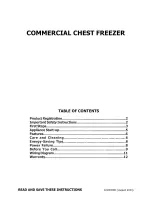
9
MAINTENANCE AND CLEANING
These units require very little maintenance. They should be cleaned periodically to keep them
running efficiently. Use the cleaning agents and suggestions in the table below for best results.
The freezers should be defrosted and cleaned whenever ¼ to ½ inch of frost has accumulated inside the
unit or if the unit will not maintain proper temperature. Use the procedures in the Defrosting section
below.
CLEANING
PART
CLEANING AGENTS
TIPS AND PRECAUTIONS
Interior and Door
Liners
Soap and water
Baking soda and water
Use 2 tablespoons of baking soda in 1 quart of
warm water
Be sure to wring excess water out of sponge or
cloth before cleaning around controls, light bulb
or any electrical parts.
Glass Doors (if
applicable)
Soap and water
Clean the glass with a mild detergent and water
on a soft cloth or sponge. Rinse with water and
wipe dry
Door Gaskets
Soap and water
Wipe gaskets and their seating surfaces with a
clean soft cloth
Shelves
Soap and water
Do not wash removable shelves in dishwasher
Exterior and
Handles
Soap and water
Non Abrasive Glass
Cleaner
Do not use commercial household cleaners,
ammonia, or alcohol to clean handles
Use a soft cloth to clean smooth handles
Do not use a dry cloth to clean smooth handles
DEFROSTING
It is important to defrost and clean the unit when ¼ to ½ inch of frost has accumulated inside
the unit or around the evaporator coils or when the unit will not maintain proper temperature.
When defrosting becomes necessary, turn the unit off by disconnecting it from the power
source.
DO NOT ADJUST THE THERMOSTAT
. Remove the product and leave the door open
while defrosting the evaporator. The frost should melt and drain through the drain tube to the
drain pan under the unit. Place towels in the bottom of the unit as necessary to help absorb the
melted frost. Once the unit is defrosted, clean it using the cleaning suggestions in the table
above. Wipe away any excess water and return the unit to service per the “Normal Operation”
section of this manual.





























